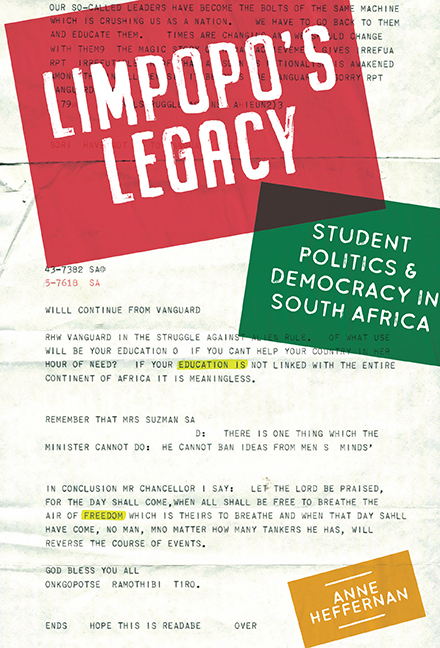Book contents
- Frontmatter
- Dedication
- Contents
- Acknowledgements
- Abbreviations and Acronyms
- Map of the north-eastern Bantustans showing the location of Limpopo
- Introduction
- 1 Turfloop, Crucible of Change
- 2 Centre of the Storm
- 3 Africanization: The New Face of Turfloop
- 4 Black Consciousness in Decline
- 5 Congresses and Comrades
- 6 Populism and the New Youth League
- 7 Julius Malema and Youth Politics in the New Limpopo
- Epilogue: Legacies of Limpopo
- Bibliography
- Index
1 - Turfloop, Crucible of Change
Published online by Cambridge University Press: 23 July 2019
- Frontmatter
- Dedication
- Contents
- Acknowledgements
- Abbreviations and Acronyms
- Map of the north-eastern Bantustans showing the location of Limpopo
- Introduction
- 1 Turfloop, Crucible of Change
- 2 Centre of the Storm
- 3 Africanization: The New Face of Turfloop
- 4 Black Consciousness in Decline
- 5 Congresses and Comrades
- 6 Populism and the New Youth League
- 7 Julius Malema and Youth Politics in the New Limpopo
- Epilogue: Legacies of Limpopo
- Bibliography
- Index
Summary
1968 was a pivotal year for student protest around the world. As discussed in the previous chapter, from Paris to Mexico City, students embarked on protests that took them into direct and violent conflict with the state. That same year in South Africa, however, student politics took a surprising – and, to some, reactionary – turn. In apparent accordance with the apartheid ideology of the South African government, black South African university students broke ranks with their liberal white counterparts and formed their own racially exclusive student organization. The racialized split between the predominantly white National Union of South African Students (NUSAS) and the black South African Students’ Organisation (SASO), is one of the key issues discussed in this chapter, as I explore the local context and causes of the break at the University of the North. It came nearly a decade after the official segregation of South Africa's universities, and the founding of ethnically exclusive ‘University Colleges’ for black, Indian, and coloured students.
On the cusp of the founding of SASO, the University College of the North, or Turfloop, in the rural Northern Transvaal, became an important centre for politically active black students. The university was less than a decade old, and had been situated on a farm miles from the nearest town. It incubated the new organization and contributed to the development of what would become SASO's core ideology, Black Consciousness, and to the related idea of Black Theology. Like SASO itself, these ideologies focused on an affirmation of what it was to be black in South Africa, and aimed to promote a positive reclamation of black identity. In the case of Black Theology, the scope of this was explicitly religious. At Turfloop and elsewhere, SASO worked through on-campus Christian groups to achieve deeper ideological diffusion and mobilization. Its strongest links were to the ecumenical and multi-racial University Christian Movement (UCM); the movements enjoyed a period of close collaboration until the 1972 dissolution of the UCM. This also marked an important moment in which SASO and its allies abandoned attempts to employ multiracialism as a strategy for political change.
During the late 1960s and early 1970s, Turfloop became a site for integrating many levels of protest.
- Type
- Chapter
- Information
- Limpopo's LegacyStudent Politics & Democracy in South Africa, pp. 21 - 66Publisher: Boydell & BrewerPrint publication year: 2019



